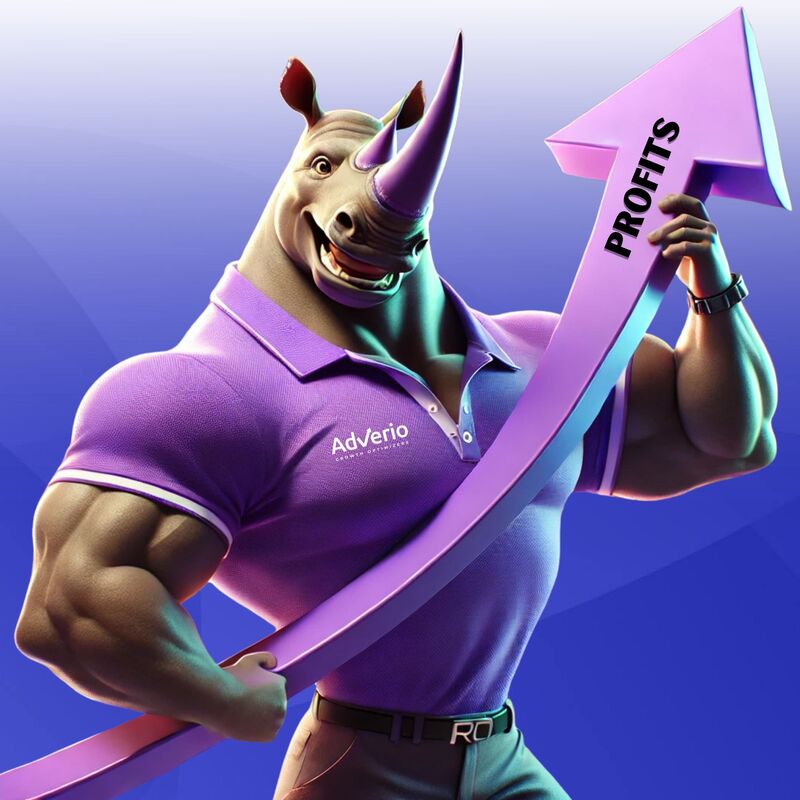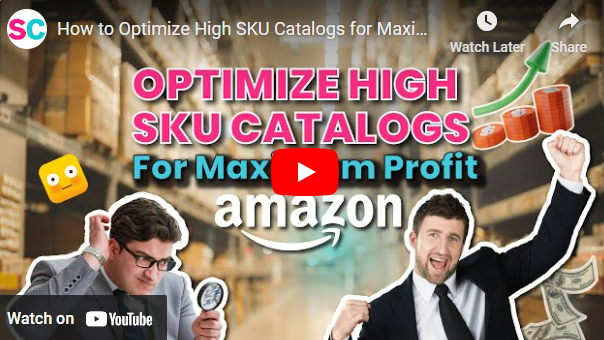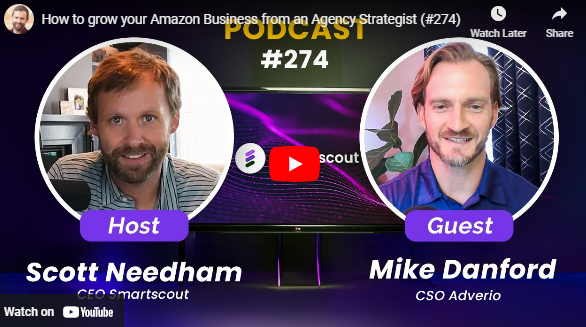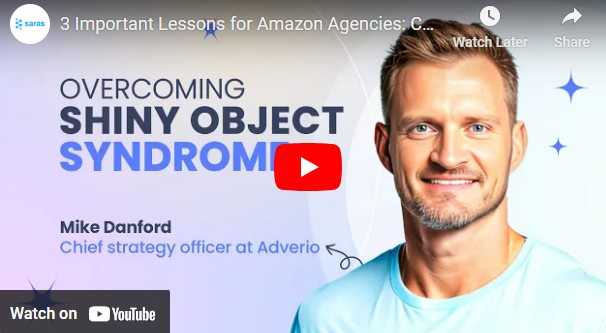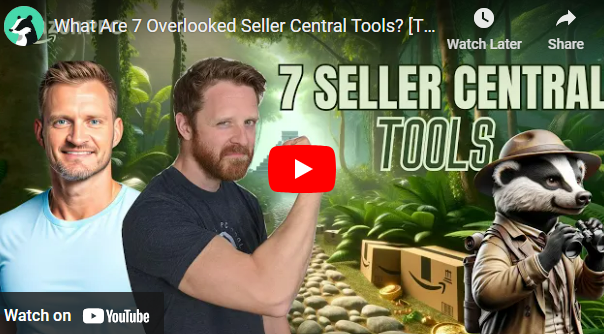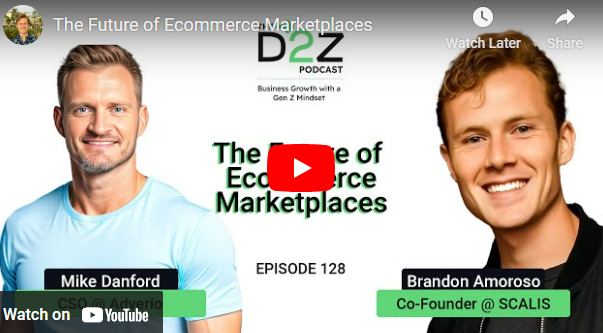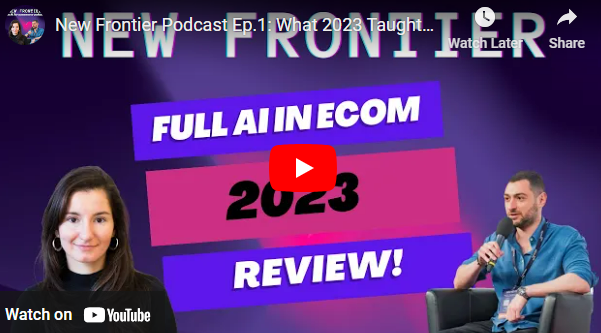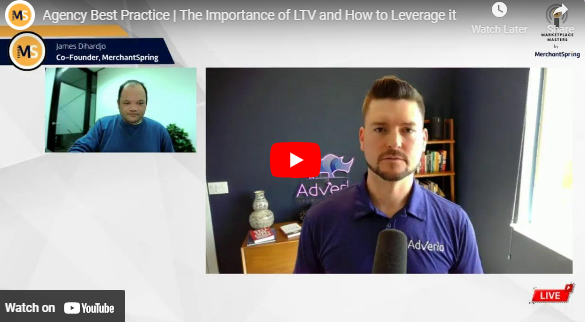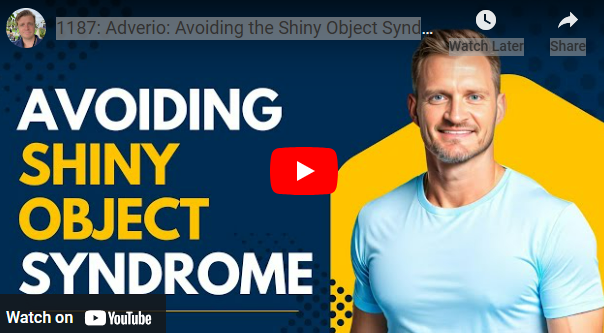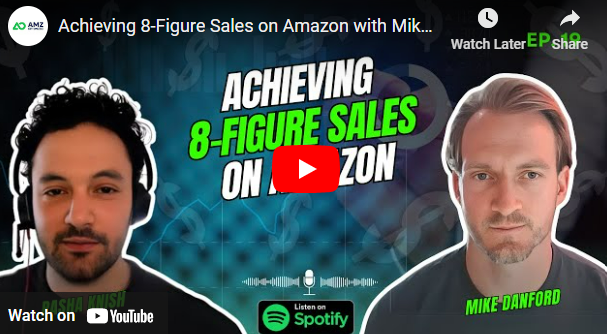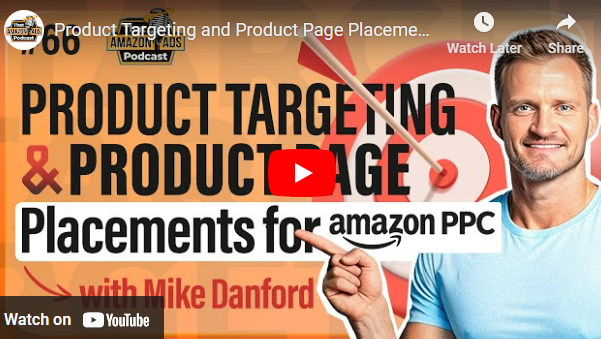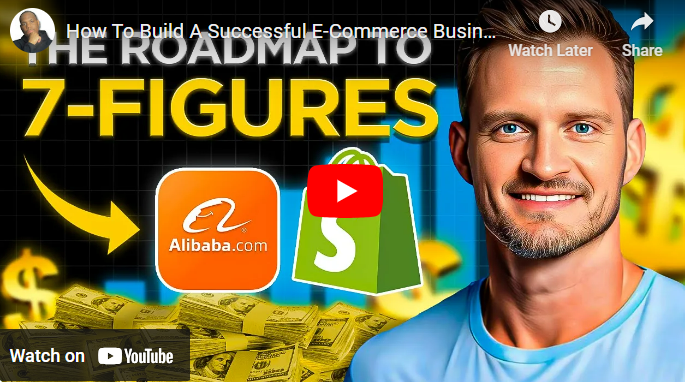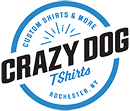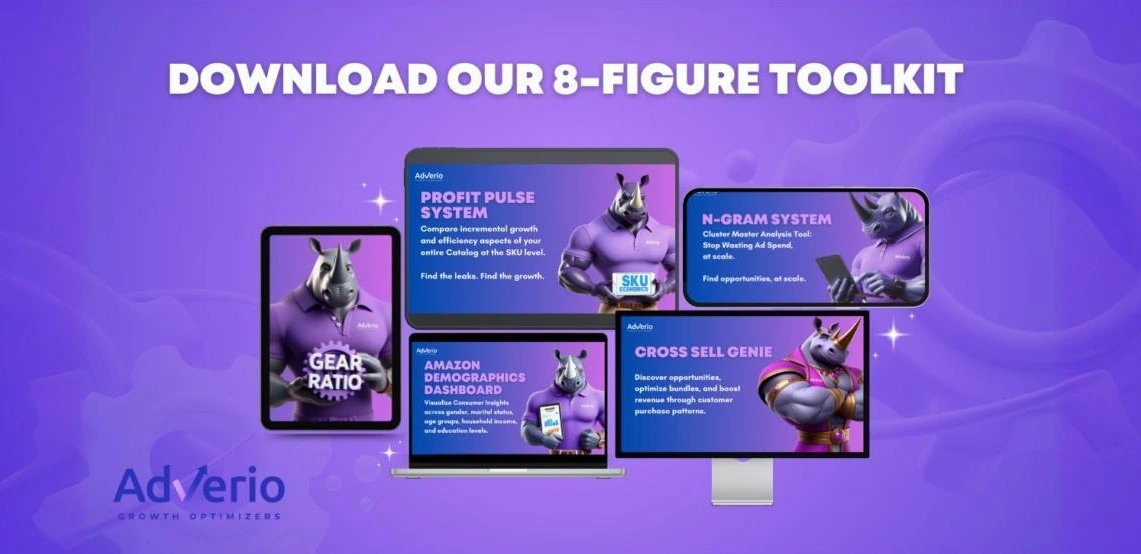Merchant Spring
Agency Best Practices that can be leveraged by fellow eCommerce brands
Discover how Alden, founder of Adverio, turned his Amazon selfie stick venture into a 25-person omni-channel marketing powerhouse. In this episode, we explore the crucial concept of Customer Lifetime Value (LTV) in e-commerce, discussing its importance, calculations, and variation across categories. Learn actionable strategies to ensure your LTV exceeds customer acquisition costs, helping you scale your brand effectively for long-term profitability. Whether you’re a startup or an established business, this conversation offers valuable insights to improve your LTV and drive success.
What this podcast covers:
- 00:03 Founder’s journey into Amazon selling and product development
- 02:24 Ad Vario’s approach to strategic partnerships and growth
- 07:12 LTV is crucial for brands in all categories
- 09:32 Understanding lifetime value (LTV) and its impact
- 14:22 Subscribe and Save programs on Amazon significantly impact LTV for consumable brands
- 16:40 Shifting focus from AC cost to LTV for better marketing decisions
- 20:32 Leverage LTV for future profitability
- 22:25 Understanding LTV calculation and tools in Seller Central
- 26:21 Accessing and leveraging LTV in Amazon
- 28:22 Leveraging seasonality and product insights for optimal sales strategy
James Dihardjo: [00:00:00]
Alden, thank you for joining me in your afternoon and my very early morning. Why don’t you kick off and tell us a little bit about yourself before we get into the guts of LTV. About yourself and and your, ad verio.
Alden Wonnell: Sure. Yeah, I think before we do that, I just want to say it’s great to to reconnect.
I think the last time we saw each other was here in the Bay Area at the infamous Wayfair Tavern. So yeah.
James Dihardjo: That’s right. That’s right.
Alden Wonnell: Legendary a burger there but yeah, happy to to dive in. So again, Alden when I’m a founder of the e commerce agency at Vario. And I originally got into the Amazon selling space around 2013.
So this was like right around the time when FBA was becoming big in the space. And allowing a lot of new sellers to come into the space. Around that time, I was working full time in finance, but I decided to give it a go and launch my own brands or products [00:01:00] really in the photographer’s photography space.
So it was really to tell you what it was a selfie stick. And what I actually did was just, I saw, that fad was on the rise. Around then and all of the ones that were in the market were just garbage except for GoPro maybe. And so I just looked at negative reviews. I made it better.
I I did better packaging, all that kind of stuff. And eventually it became a bestseller in the category within about three months. So ended up being selfie stick and other related terms. And and that was a wild ride. So again that’s how I got started and then by way of that went into consulting.
I was part of a network of other, e commerce entrepreneurs and they started coming to me for advice. That’s how things started, but I was still like afraid to jump ship. And then, fast forward to 2018, I left my job at the San Francisco startup. That was, it actually ended up being boring.
I learned a lot. But that kind of gave way to me starting at Vario in [00:02:00] 2019. So that’s that’s how I got into the space.
James Dihardjo:
And what, why don’t you tell us a bit about how Adverio is different to other agencies? At least I feel like you guys have a different service, different kind of offering compared to the rest of the market.
Alden Wonnell: Yeah. I’d like to think so as well. We are very like leading edge, very technology focused, always trying to push the envelope. At this point, starting in 2019 to 2024, we’ve grown into a 25 person omni channel marketing partner. I really hate the word agency. But I, we really see ourselves as strategic partners in the space.
Primarily focusing on Amazon, Walmart, but also serving Target, Shopify, Instacart, and other channels that are brand partners. Want to sell on, right? And in that space, we really found our stride with mid seven figure to mid eight figure brands specifically with large catalogs and.
It’s interesting because when we first started up, we were, emerging sellers, six figure brands, but one of [00:03:00] our first brands was a mid seven figure brand. I think we just struck that by luck, but pretty soon after that, we took on other mid seven figure, low eight figure brands. And we noticed they all had the same issues, right?
They all had these same issues with scaling where they had gotten from like zero to. Seven figures, mid seven figures. And then they just couldn’t scale past that. And, most of those issues were around like trying to use the same strategy. To get to seven that they were to try to get to eight.
And as you probably know from growing your business and just from hearing others in the space, like the strategy has to completely change, like there are some fundamentals that stay there. As things grow, you get a larger catalog, it just gets exponentially more complex in every place.
So we basically. In 2021 decided to really just focus on scaling technology, scaling, tools, et cetera. And in areas that address every part of the [00:04:00] business. So advertising, SEO, catalog, optimization, pricing, optimization And it’s been massively successful. So we’re, regularly seeing like double digit, triple digit growth year over year.
And it’s really about implementing these tools and strategies that have gone by the wayside and giving these brands, the resources that they need, the strategy that they need. And it. It really ties into a lot of these strategies tied directly into our topic for the day, which is LTV. And guess what?
Like when we fix all of these issues, these brands typically see their LTV skyrocket or at least make a significant improvement. So it all ties in to the topic for today.
James Dihardjo:
Yep. Yep. No, for sure. So just on that, so I guess. We’re really talking about LTV, right? So why don’t you give us some background on LTV in the context of Amazon?
Alden Wonnell: Yeah, sure. So what is [00:05:00] LTV? I think let’s start with that question because some of the listeners might not really know what it means. It is. Your customer lifetime value, or some people call it CLV. Some people call it CLTV. Let’s just go with LTV for today. And there’s a number of different calculations to, to try to find that out.
The most simple calculation is really just your average order value or customer revenue times your average number of transactions per year, times your. Customer lifespan in years. And so what that gives you, James, is it gives you their total top line revenue in terms of a value of the average customer.
Does that make sense?
James Dihardjo: Yep. Totally.
Alden Wonnell: Yeah. And it basically it’s a universal KPI for businesses. I think every business should be tracking this. And it really, because it can dictate, what you should be, willing to spend to acquire a new customer, what, what your tacos should be, what your ACOS should be.
And we can get dive more into that. [00:06:00] But interestingly, from my experience, like brands that started outside of Amazon especially in the seven, eight figure plus range, they definitely know their LTV. It’s a metric that they track consistently. They peg it to their. To their industry, vertical, et cetera.
I’m sure, being at merchant spring selling, having a SAS solution it’s something that you track as well, right?
James Dihardjo: Yeah, a hundred percent. I think it was, like you said LTV is almost universal in usage and business, like definitely for SAS. I can see why it’s important and probably I can see why it’s important for brands.
But just on the brands thing, before we get into, what’s good and bad do you think that the LTV stuff is relevant for all categories? Or do you think like how is it relevant to everyone? Or less relevant or more relevant?
Alden Wonnell: Yeah, I think there are categories. That’s a, it’s a great question.
I think there are categories where it’s more relevant. And I think there’s categories where, your LTV might just be a one time purchase, but [00:07:00] the idea behind this, like a category where it might be more relevant is maybe like food. Or supplements or cosmetics because people, these are consumable items that you would expect someone to purchase again and again.
Now, if we go to a sector, that’s, I dunno, let’s talk about like industrial or tools, for example. I think that while it’s less impactful there, maybe it’s still very important because there’s while, in cosmetics and every, I guess what I’m getting at is that there are things that they can do to increase their LTV.
By increasing the market basket, the checkout, different items that they’re coming back for. And so I think that’s actually an area of opportunity for those industries that may not think that it’s like that significant for them. I do, there’s a couple of examples of. Brands that we work with that see repeat purchases all of the time have [00:08:00] super high LTV.
And then there’s, a brand we work with that sells like oil pumps and grease pumps and gas pumps. And they think, Hey, someone’s just coming for a one time purchase for their tractor. But that person ends up coming back for a a service hose in their workshop, so it’s things like that actually Become unexpected in those types of categories.
James Dihardjo: Yeah. Yeah. This is a good segue into. What is a bad or a good lifetime value, and I guess, how do you even establish we were just talking about the differences for different categories but how do you even establish what’s good and bad for you as a brand?
Alden Wonnell: Yeah, I think, it’s a good question. I think, okay, you, you want your a good LTV is norm for a good or a bad LTV, right? The, a good LTV is typically when it’s higher than your customer acquisition costs, right? That means that, and at least being equal to your customer acquisition costs. So if your LTV is higher than your customer [00:09:00] acquisition costs, that means that, after you take out your, Amazon fees and your costs to acquire that customer, if that’s positive.
Then that’s that, that’s a good LTV, for example. And in terms of a bad LTV, that’s really subjective because it just depends where the business is at. So if the, if your customer acquisition costs is higher than your LTV, then you’re losing money. So that would be a bad LTV. And why I say it’s subjective is that.
Is that, emerging brands, startup brands, et cetera, they always have to spend more on acquiring new customers out of the gate once they become more established, have reviews, have a larger catalog, et cetera, then things start to even out. But it’s just like starting any business. You have to, first start that flywheel.
Get customers in the door and then keep selling to them, right? Do you have a different perspective on it?
James Dihardjo: No, I think that’s that’s pretty, it’s, it sounds pretty similar to the software [00:10:00] space. So no, I don’t actually. What other metrics? LTV, should a brand or even an agency be looking at?
And, we’ve just touched on customer acquisition costs. That’s another metric that’s relevant, right? What else is up out there?
Alden Wonnell: Yeah. So I think, profit margin, obviously. So when you’re looking at LTV, you’re looking typically at a top line revenue number And, like I said before, you want to take out the Amazon fees or any fees related to COGS, manufacturing, logistics, whatever, Amazon and then your marketing dollars to acquire the customer.
Definitely want to look at your LTV after those costs, right? As compared to your cost per acquisition. The other thing to look at would be your average order value. So if you can get your average order value to increase over time and do that by basically, supporting multi packs, supporting size, color variations cross selling upselling accessories, for example, that’s [00:11:00] something brands should look to do.
And naturally happens if their brand is merchandised well. So that’s another thing to look at is your average order value. Other things to look at would be repeat purchase rate, right? So if there is a metric for this in Amazon. It’s, we can dive into it more if you’d like, but it can give you a baseline LTV, but really it just tells you what percentage of your sales and orders are repeating from one time period to the next.
And typically quarter over quarter, and especially year over year, you want to see those repeat purchases. At least staying the same, but ideally increasing because there’s really three ways to increase LTV. It’s, increase your average order value, increase your repeat purchases, or, increase the retention of the customer over a number of years.
So if we can get them to purchase more times in a year then the LTV goes up, right? So basically that’s your like subscription rate or your turn rate. If you want to talk about it in SAS terms. Yep.
James Dihardjo: Yeah. Got it. [00:12:00] No, I’m on the same page. Just a quick question. How much interplay do you see between like your, this is Amazon specific.
So how much interplay do you see between subscribe and save programs and, driving a better LTV? Do you see much of that from your clients?
Alden Wonnell: Yeah that’s, it’s pretty big. And I would say the places we see that mostly are in the food space. So food and cosmetics, as I mentioned before it.
In some, we have a, there’s like a hemp brand, a protein brand, a cosmetics brand, they all have super high repeat purchase rates. We work with a couple of supplement brands that have somewhere around a 50 to sometimes 60 percent repeat purchase rate. So for those. Brands selling consumables.
Yes. I mean that like having subscribe and save and the fact that Amazon just like basically created an auto enrollment program for it. It’s it has, it’s a huge [00:13:00] contributor to LTV, but again, not every product can be on subscribe and save, those that can see a massive benefit from it typically.
James Dihardjo: Yep. Got it. Okay. Yeah. So coming back to a bit of an agency angle to all this. As an agency, how do you educate your clients on all of this LTV, CAC, AOV, subscribe and save? How do you actually educate them on all this stuff?
Alden Wonnell: Hopefully they’ll watch this webinar. No, I’m just kidding. But it’s, so I want to go back to what something I was saying before, which is I’ve noticed that brands that start off of Amazon know their LTV typically like 90 percent of the time, but brands that started on Amazon and came up on Amazon, that’s where they found their success before branching out.
They don’t know their LTV. A lot of the times they don’t think it’s really important. And I think that’s a function of Amazon just making it very difficult to actually. Come down to that [00:14:00] number or calculate that number and not that, you basically have to take a bunch of different pieces and put them together and then and get that number right?
Or you have to have a third party software. There are indicators that Amazon gives you from the repeat, purchase dashboard from the customer lifetime dashboard. Each of them have interesting insights and tools, but they like don’t give you the whole. The whole perspective and so back to your question about, how do you educate them?
It’s a learning curve for them because they’re focused. Most brands are focused on a cost and thankfully. That is shifting towards tacos, right? Because every agency is talking about tacos now, which is, I think it is a good move because most brands use a percent of revenue model to fund marketing and not an ACOS or efficiency metric.
So that’s a good move. The next move is to LTV. If it’s really applicable to them, I think it’s applicable to every business. And so that, that is the next shift and why it gets some [00:15:00] pushback is because almost always the answer is, Hey, you’ve got a really good LTV. You should spend more money on marketing.
And that’s the last thing they want to hear. So it’s really push and pull it. I think it with some clients some brands, they get it right out of the gate but the majority, it takes, it does take education. And the way that we do that is before we even take on a brand, we do an LTV analysis for them.
Then when we do take them on, we run it quarterly, every quarter after that to track how things are going. We also do that because you lose customer data every month that you can’t really get back unless you’re pulling it into a data warehouse. That issue aside. Once you start tracking it and showing them these reports, they start getting, Oh, this is an interesting metric.
This this isn’t just a one time thing that you showed me. I’m seeing this increase over time. Maybe I do, maybe I can invest more. In acquiring a new customer. Maybe I can maybe I’ll have more cashflow because [00:16:00] of this, to launch a new product down the line. Maybe I’ll have more dollars for tent poles spend down the line.
And so it is, generally. There are some receptive, very receptive brands, but in the most part, it’s like crawl, walk, run, if you will,
James Dihardjo: Yeah, I hear just quickly in the end and I’m going to blast through the next set of questions in the interest of time, just on the agency angle how do you think measuring, maybe measuring and talking to the clients about a, I don’t know, maybe a target LTV they want to get to shapes the whole strategy.
Like, how do you see that, if you imagine that the listeners here are all agencies, how do you see how you think that this can help shape the client strategy?
Alden Wonnell: Yeah. Okay. So let’s, I guess in the, I’ll try to speed through this, but let’s say that. Your client wants or the brand, if you’re a brand watching, you want a 10 percent cost, right?
You’re willing to spend 10 to get a customer. That’s going to spend a hundred dollars with you. And you’re basing that off one purchase, right? You’re [00:17:00] not taking into account that they’re going to come back. A number of times. Let’s say that person on average, or your customers on average purchase two times a year and their average lifetime is two years.
So two times two is four times a hundred. We’ve got 400 now you should be willing to spend 40. In the same light, that 10 percent to acquire that customer. Now, what that’s going to do is, what you do is invest more in marketing and top of, budget and top of ad top of search ad placements and you potentially, you take those customers on potentially at a loss for that first.
For that first purchase, within a defined time range, like three to six months, they’re going to have way more profit down the line. So it’s really about funneling these new customers and for a future payoff. And typically a. A relatively short term payoff in the terms of business growth year over year.
So that’s the first way. The second way is to basically use it to forecast cash flow to finance things like inventory, new product launches, like [00:18:00] I mentioned before, tentpole ad spend. Because that’s the other thing. It’s not just, Hey, we’re going to be way more profitable, but what do we do with those profits?
Once we realize them right now, we have more money to grow faster in operations and other areas, not just more ad spend. And so those are the, those are two, those are the two main places, but I do want to mention this because it’s a really intriguing way to use LTV as well.
And that is the avoiding price. Discounting and price wars, essentially you’re discounting. So if you think about this, why do brands discount? They discount maybe to get rid of inventory. That’s not selling through. But they also discount to acquire a new customer ahead of one of their competitors, right?
What if you don’t want to lose your brand integrity? What if you don’t want to price down now, if you look at it in terms of LTV, if I was going to give a 20 percent price discount. Maybe I’ll just spend 20 percent more on acquiring that customer and keep my price the same, right? That way you [00:19:00] keep your brand integrity level and you don’t have to participate in that price war, which always ends badly, right?
James Dihardjo: Yeah. No, that makes sense. That’s it. That’s a good take on it, especially for people that are all new to this. This is a very good take. Yeah. Jumping ahead. I guess this is more of a measurement theme. And how do you actually calculate this? These crazy numbers? You and I were talking about new tools available and seller central.
Can you tell us more about that to start with? Like tools to calculate this natively?
Alden Wonnell: So natively, not really much. Okay. There’s the repeat purchase dashboard that let’s talk about how you might calculate like a very raw calculation with that. In the repeat purchases behavior dashboard, which is in brand analytics what you’ll do is if you pull up the last year, you’ll see what your.
Repeat purchase rate is I like to look at it by the year, but you can look at it by the quarter. You can also look at it by the week or month. [00:20:00] Let’s say your average purchase, your average AOV again is a hundred dollars, the dashboard tells you that 50 percent of the customers that purchased last year purchased again this year, right?
That means that customer last year spent a hundred dollars. And then half of those customers came back and spent 50, right? Or half of them came back. So essentially what you can do there is you could say My, my, my lifetime value of that customer is 150. So not just a hundred, but it’s 150 because 50 percent of the people are coming back and buying the next year.
Now that’s a very kind of rudimentary baseline pulse. It doesn’t take into account market basket analysis, like product level LTV. It doesn’t take, there’s a lot that it doesn’t take into account. Not to mention, it doesn’t take into account. Multiple years of a customer being a customer, right?
It only takes into account the last 12 months. So that’s one way, and that can get you like a baseline, but there is, there’s a couple of other tools that can be used as [00:21:00] well. So the other tool that’s available in seller central was just launched in October. And it’s called the customer loyalty analytics dashboard.
And that’s also in brand analytics. And this is a step in the right direction, but it’s still the layout, the UI it’s confusing at best, I think for most people. And what it does is it offers a. A segmented cohort analysis of LTV. Again, only this year versus what they think is going to happen next year.
It uses predictive LTV and RFM models. I won’t go into all the details there, but you basically got top tier clients. You’ve got promising customers, you’ve got at risk customers, and you’ve got hibernating customers. And it gives you some detail about what they spent this year and what they think. They’re going to spend next year.
And from there, it allows you to launch promotions to those cohorts or segments using brand tailored promotions. So very limited in terms of what you can do with the [00:22:00] data. It is a little bit more comprehensive. And it’s a cohort based LTV analysis. So again, you’ve got these two dashboards that can help you.
But again, they still do not give you the full picture that you need. So that’s what’s available now. It’s a good start. I would say.
James Dihardjo: Got it. I did. I was just looking at my notes and I just made a note earlier to make ask you this question, how do they get access to this?
So you mentioned you got here, band analytics, and then. Customer loyalty analytics. By default, do does every seller account that has a brand in the brand registry get access to this? Or is there something else they actually have to do
Alden Wonnell: As far as I’ve seen? Yes, I think that all the brand needs to do is get access to brand registry.
And then for an agency or a user to get access to it, you actually have to go to Global permissions and user permissions. So not only do you have to have access to, Amazon keeps updating user permissions, but in regular permissions, you have to get access to brand analytics dashboard, [00:23:00] and then the owner has to go to global user permissions and enable the brand, all those brand analytics features as well as other promotional features like brand tailored promotions.
In terms of access, that’s we haven’t worked with a brand registered brand that hasn’t had access to it. So I got it.
James Dihardjo: Okay. Yeah, cool. Yeah, I just thought I’d ask because sometimes Amazon can be slightly different region to region as well, like in terms of what’s available in there.
But yeah, thank you for clarifying that. Two more questions. So now I talked about the Okay. Natively managing it inside Amazon. Now you now imagine like now we’ve got the metric, right? So how do you actually leverage that in your e-commerce business? This is more from a brand perspective now, as opposed to the agency angle we talked about before.
Alden Wonnell: Yeah. I think what we do is a little bit different. We don’t use a third party tool because three years ago, four years ago, I think now at this point, we created our own tool, [00:24:00] our own LTV tool. And it’s just a spreadsheet based tool. We’re actually building it into our proprietary dashboard right now.
But essentially what you have to do is just download the customer order data. And you basically pivot it in a number of different ways look at different cohorts within that you can look at product level LTV. And so that’s how we do it right now. It’s a manual, but very like process, productized process that we’re able to pull it on a regular basis.
And again we’ll look at it, we’ll look at it throughout the year. We’ll talk to the customer about it or the brand. And there are certain insights there. Certain times of year cer, sorry, certain times of the year when certain products sell better or have more repeat purchases, so it makes sense to maybe push those products during those times of year.
So there is some seasonality factor. There is. Pushing best sellers versus, accessory items or cross sells upsells and how we can build that into things. And that’s basically [00:25:00] how we leverage it in the business. But when the brand realizes that, Hey, I could actually, I should accept shoppers at least testing it as something that we typically do And it usually pans out in the right way.
So I don’t know if that answers your question, but that’s not how we’ve been. Yeah, there’s other tools that we’ve tried, but they’ve all been missing something. So we just created our own tool.
James Dihardjo: Yeah, it makes sense. Yeah, I do have a question for everyone. So that tool you mentioned the free tool you’re going to provide us with a link, to share that. Everyone who registered for this webinar. Yeah.
Alden Wonnell: Yeah. Yeah. We have basically like a free Amazon toolbox that goes over like 12 different tools and seller central that are basically overlooked by. The majority of the time. So it goes over like how to access those tools.
There’s education, like blog articles and videos about those tools. And there’s actually our own proprietary tool for each one of those 12, the, those 12 seller [00:26:00] central features. So if you want it, it’s free. You can go to adverio. io forward slash merchant spring to go and grab it, grab your free copy.
And if you need any help with it we’re here to help. We’re hoping that people give it a try and really find some value in it.
James Dihardjo: Yeah, cool. All right. Look, we’ve just hit 30 minutes, which I think is the max. Anyone wants to listen to? Oh, no, two of us. But look, thank you very much for making time talking about that.
I think if anything, I think it hopefully just keeps fueling that shift in, in what people are talking about and focusing on their clients. So yeah, really appreciate it.
Alden Wonnell: Yeah, I think I really do think it’s the next big shift. And yeah. Yeah. It’s a pleasure as always. Thanks for thanks for the time and reconnecting again.
James Dihardjo: Thanks, Alden. Thanks.
Want more like this? Headout to our website and watch all the other podcasts Adverio has featured. Get snippets from all episodes by following us on Instagram @Adveriogrowth and Youtube @growwithadverio
Stuck on Amazon, Walmart, or Target?
Grab our 8-FIGURE TOOLKIT – Discover how our proven strategies can generate profits and drive growth.

